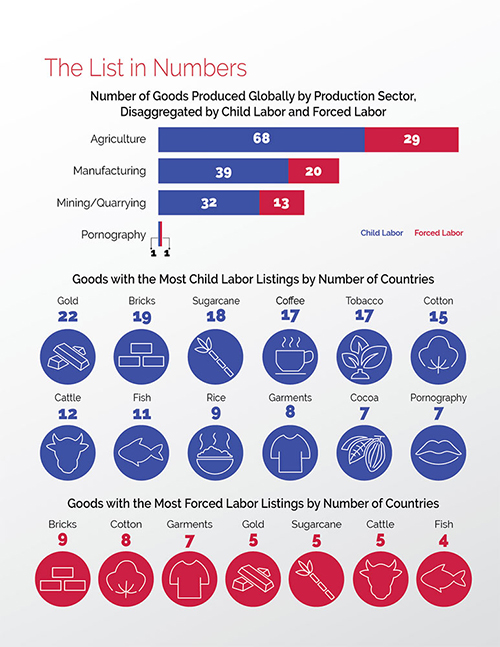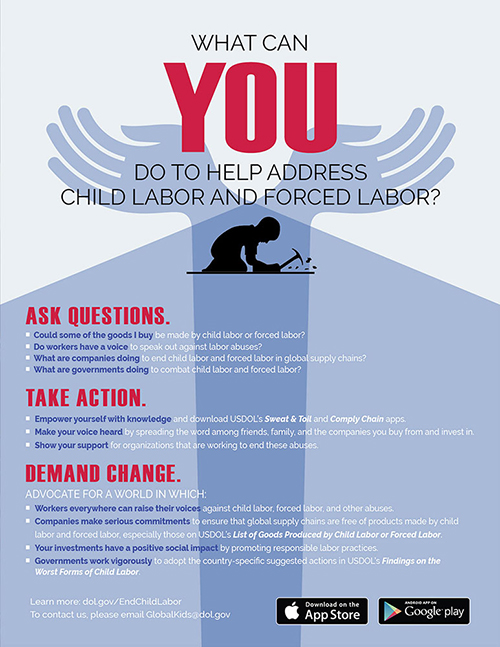List of Goods Produced by Child Labor or Forced Labor
The Bureau of International Labor Affairs (ILAB) maintains a list of goods and their source countries which it has reason to believe are produced by child labor or forced labor in violation of international standards, as required under the Trafficking Victims Protection Reauthorization Act (TVPRA) of 2005 and subsequent reauthorizations. The List of Goods Produced by Child Labor or Forced Labor comprises 156 goods from 77 countries, as of June 23, 2023.
ILAB maintains the List primarily to raise public awareness about forced labor and child labor around the world and to promote efforts to combat them; it is not intended to be punitive, but rather to serve as a catalyst for more strategic and focused coordination and collaboration among those working to address these problems.
Publication of the List has resulted in new opportunities for ILAB to engage with foreign governments to combat forced labor and child labor. It is also a valuable resource for researchers, advocacy organizations and companies wishing to carry out risk assessments and engage in due diligence on labor rights in their supply chains.
The countries on the List span every region of the world. The most common agricultural goods listed are sugarcane, cotton, coffee, tobacco, cattle, rice, and fish. In the manufacturing sector, bricks, garments, textiles, footwear, carpets, and fireworks appear most frequently. In mined or quarried goods, gold, coal and diamonds are most common.
ILAB published the initial TVPRA List in 2009 and updated it annually through 2014, following a set of procedural guidelines that were the product of an intensive public consultation process. ILAB now updates and publishes the List every other year, pursuant to changes in the law.
Procedural Guidelines
On May 15, 2020, ILAB's Office of Child Labor, Forced Labor, and Human Trafficking published Procedural Guidelines for the development and maintenance of the List of Goods from countries produced by child labor or forced labor in violation of international standards.
| Country/Area | Good | Exploitation Type |
|---|---|---|
| Cambodia | Child Labor | |
| Ukraine | There are reports that children as young as 7 engage in illegal amber extraction in Ukraine. Children from low-income families in the Polesia region of western Ukraine, including in Rivne, Volyn, and Zhytomyr Oblasts, are particularly vulnerable to involvement in amber extraction. For example, one human rights organization reports that thousands of school children extract amber, and that their labor is essential to the amber industry. According to media reports and local government officials, child labor is systemic in the illegal amber extraction industry and is a growing problem. The amber extraction process creates large pits and exposes children to risk of injuries when extraction pits collapse. Children engaged in illegal amber extraction are also at risk of violence at the mining site. |
Child Labor |
| China | Forced Labor | |
| Dominican Republic | Child Labor | |
| El Salvador | There is evidence that children ages 5 to 17 are engaged in the production of baked goods in El Salvador. According to the Government of El Salvador’s Multi-Purpose Household Survey of 2015, a working child is considered to be engaged in hazardous child labor if the child is performing work that is hazardous according to national legislation. The survey estimates that 123,259 children ages 5 to 17 perform hazardous child labor in El Salvador, including using dangerous tools, carrying heavy loads, working with chemicals, working long or night shifts, and being exposed to dust, smoke, or extreme heat or humidity. Approximately 9,737 of these children in hazardous child labor are engaged in the production of baked goods. The release of this survey demonstrates the Government of El Salvador’s commitment to addressing child labor and its acknowledgement that data collection is vital to the design and implementation of sound policies and programs. |
Child Labor |
| Burma | There are reports that children as young as age 10 are forced to work in the production of bamboo in Burma. According to the ILO and NGOs, forced child labor is pervasive, particularly in Karen, Shan, and Arakan States near military camps, with children constituting up to 40 percent of forced laborers being used for a variety of activities, including the production of bamboo. Some of these children are sent by their families to fulfill a mandate imposed by the military that requires each household in a village to undertake specified forced labor activities. Villagers, including children, are forced by local officials and the military to work cutting bamboo for the military camps. The forced child laborers are not paid for their work, and face physical violence or other punishment if they refuse to work. |
Child Labor, Forced Labor |
| Belize | Child Labor | |
| Brazil | There is evidence that children ages 5 to 13 cultivate bananas in Brazil. The Government of Brazil’s 2015 National Household Survey considers all work performed by children below age 14 to be child labor. Based on an analysis of the survey, an estimated 2,936 child laborers cultivate bananas. The ILO has found that generally children who work in agriculture may be at risk of exposure to hazards including, working long hours, carrying heavy loads, using dangerous tools, and exposure to the elements, physical injuries, and chemicals, such as pesticides. The release of this survey demonstrates the Government of Brazil’s commitment to addressing child labor and its acknowledgement that data collection is vital to the design and implementation of sound policies and programs. |
Child Labor |
| Ecuador | Child Labor | |
| Nicaragua | Child Labor |
your hand? Download ILAB's Sweat & Toil App today!
chains? Download ILAB's Comply Chain App Today!




